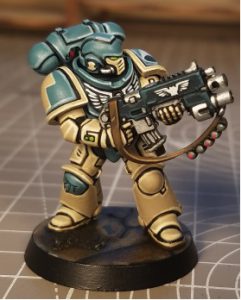I’ve had a lot of questions about how I accomplish my scheme for my home-brew chapter “Ot Neba.” This is a specific guide for my scheme. The steps could be used to paint any reasonably bright power armor, though I would expect it wouldn’t work with anything close to black (always shade your blacks).
I paint with the goal of achieving something more like an illustration than a realistic depiction, mostly because I have no artistic background and struggle to get good, realistic lighting effects. I also feel like a more cell shaded, black-lined model looks great both up close and at a distance, while hyper-realistic models look washed out at a distance.
That said, this scheme is tedious and time intensive. Conservatively, this scheme takes 8 hours a figure.
I start by airbrushing the model in Jack Bone (all paints P3 unless stated otherwise). The torso, groin and right kneecap are painted in Trollblood Base. The sublayer is painted Greatcloak Grey and any metals are hit with gunmetal (Vallejo air). The details I plan on painting white are hit with a 50-50 mix of Frostbite and Trollblood. At this point only the armor and metal are blocked out, basically anything I plan on hitting with a wash. I don’t preserve any black except for the recesses in the chest logo, everything else will be blacklined.
At this point I hit everything with a satin-gloss varnish to allow inks and washes to pool more aggressively.
I use a cheap brush to black-line all recesses with black ink. Do not worry about where light will or won’t fall, that is not the point. The point is to create contrast. This is tedious. Don’t worry about mistakes too much, you will be re-applying the base-coat, but do try and keep the lines thin so the wash will be visible later.
Slop the appropriate shade all over that model. Heavy, heavy, heavy. It will look awful, that’s OK. I use Nuln for the sublayer, Agrax for the cream and Drakenhoff for the chest and whites (all washes are GW). Once you are extra, extra sure the wash is dry hit the whole thing in a matt varnish so your paint will take without beading. I like mecha matt varnish by Vallejo. Metals are done with both Drakenhoiff and Nuln washes.
This is when you start to get something that looks like you know what you’re doing. Leaving the recesses, get as smooth a layer as you can with Jack Bone and Trollblood. P3 covers very well, but you’ll still likely need 2 coats or more. The goal is to get as smooth and clean a line you can manage uncovered that shows the black inkline as well as a hint of the brown or blue remnants of the wash. This is the step that will make or break the model, and will take a long time. Metallics are given the same treatment with Vallejo Steel.
I use a very aggressive 4 stage edge highlight, more focused on what will be visibly interesting than realistic. The blue highlight is working up from Trollblood to Frostbite ( 75/25, 50/50, 75/25, 0/100) and the cream is managed with Menoth White base, Menoth White highlight to Vallejo white (100 MWB, 50-50 MWB/MWH, 100 MWH, 50 MWH/W). The first stage highlight should cover literally every line on the model, then the second through 4th should hit raised surfaces where light will show.
Detail work.
The whites are accomplished by working up from Frostbite to vallejo white.
Leathers are wetblended from Battlefield Brown to Gun Corps Brown then highlighted with GCB mixed with Moldy Ochre and Jack Brown
Eyes and lenses are Greatcloak Grey/Gnarls Green, Necrotite Green and Cygnus Yellow
Lights are Khador Red and Necrotite green over a white base coat.
Gun casings are Coal Black highlighted with a ~60/40 mix of Coal Black and Arcane Blue
Basing is complicated, if y’all would like a tutorial I can make one. The gist is a bunch of super watered down paints applied almost simultaneously and then smothered in washes.
The finished product. Again, you want to hit the lot with a matt varnish and job’s a good one. It’s a time intensive process but the only skills really required are a steady hand, watered down paint and patience. I’d be happy to address any questions in the comments.
-J










